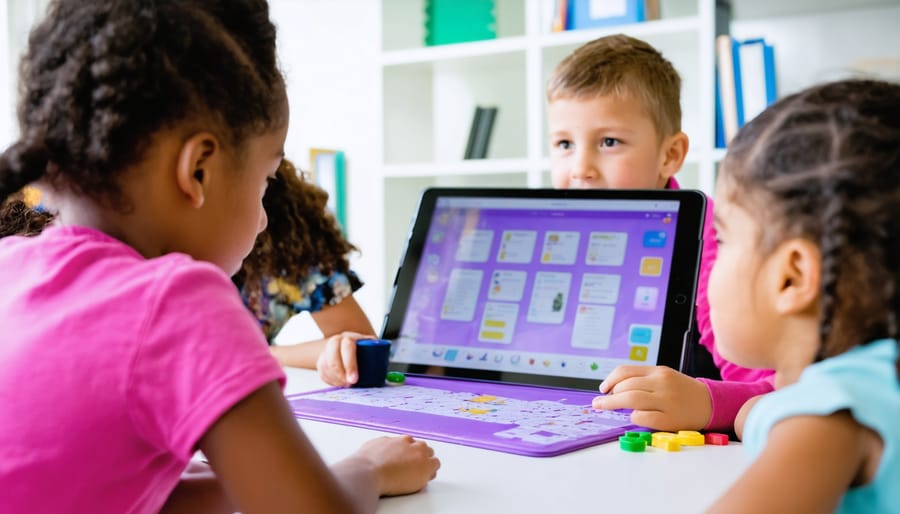Make Your Language Classes Come Alive with These Engaging Online Games
Transform your language classroom into an engaging digital playground with online learning games that captivate students while delivering measurable results. Interactive language games harness students’ natural love for competition and achievement, turning routine vocabulary drills and grammar practice into exciting challenges they actually look forward to completing.
Today’s most effective online language learning platforms combine colorful graphics, immediate feedback, and progress tracking to create an immersive experience that keeps students motivated and accountable. Whether you’re teaching elementary Spanish or advanced Mandarin, these digital tools adapt to different proficiency levels, learning styles, and classroom dynamics – making differentiated instruction easier than ever.
By incorporating games like vocabulary races, pronunciation challenges, and story-building adventures, teachers report increased participation, better retention, and a more positive attitude toward language learning. The best part? Most of these resources are free or low-cost, allowing you to experiment with different platforms until you find the perfect fit for your classroom needs.
Why Online Language Games Transform Learning
Instant Engagement and Motivation
Online language learning games are dynamic tools that naturally increase student engagement through their interactive and rewarding nature. Students become actively involved in their learning journey as they compete, collect points, and unlock achievements. The immediate feedback these games provide creates a positive reinforcement loop, encouraging learners to keep practicing and improving their language skills.
Unlike traditional worksheets or textbook exercises, games tap into students’ natural desire for fun and competition. When learners see their progress through level-ups or leaderboards, they develop an intrinsic motivation to continue learning. The variety of challenges and activities keeps the content fresh and exciting, preventing the boredom that often comes with repetitive language drills.
Teachers often notice that even reluctant learners become more enthusiastic participants when language practice is transformed into an engaging game-based experience. This enhanced motivation typically leads to longer practice sessions and better retention of language concepts.

Real-Time Progress Tracking
One of the most exciting features of online language learning games is their ability to track student progress in real-time. As students play, these digital tools automatically monitor their performance, providing instant feedback on pronunciation, vocabulary retention, and grammar usage. This immediate response helps students understand their mistakes and celebrate their successes right away, rather than waiting for traditional assessments.
Teachers can easily monitor individual and class-wide progress through user-friendly dashboards that display detailed analytics. These insights show which language concepts students have mastered and where they might need additional support. The data helps you make informed decisions about lesson planning and identify students who might benefit from extra practice or more challenging content.
Many games also include built-in achievement systems that motivate students through badges, level-ups, and progress bars. These visual indicators of success encourage continued engagement and help students take ownership of their learning journey.

Popular Online Language Game Types
Vocabulary Building Games
Vocabulary building games offer an exciting way to expand students’ word knowledge while keeping them engaged. Word matching activities let students connect terms with definitions or pictures, making abstract concepts more concrete. These games work especially well for visual learners and can be adapted for different difficulty levels.
Digital flashcards have evolved far beyond their paper counterparts, now featuring interactive elements like audio pronunciation, example sentences, and progress tracking. Students can create their own sets or use pre-made ones, making review sessions more personalized and effective.
Memory games add a fun challenge by testing both vocabulary recall and concentration. Students flip virtual cards to find matching pairs of words and definitions, helping reinforce word meanings through repetition. Many platforms allow you to customize these games with your own content, perfect for unit-specific vocabulary or targeted language skills.
Try incorporating these games as warm-up activities or end-of-lesson rewards. You can also use them for homework assignments, as most platforms track student progress and provide detailed performance reports. The competitive element of these games naturally motivates students to engage more deeply with new vocabulary.
Grammar Practice Games
Grammar practice doesn’t have to be boring! Interactive grammar games bring rules to life through engaging activities that students actually enjoy. Popular options include sentence-building puzzles, where students arrange words to create correct structures, and verb conjugation challenges that turn traditional drills into exciting races against the clock.
Many platforms offer drag-and-drop exercises for parts of speech, making it easy for students to visualize how different words function in sentences. Word order games help learners master complex structures through playful experimentation, while error-correction games sharpen their editing skills.
These games often include progress tracking and immediate feedback, helping students identify areas for improvement. Some even offer customizable difficulty levels, perfect for differentiated learning. The competitive elements, like leaderboards and time challenges, motivate students to practice repeatedly, reinforcing their understanding of grammar concepts through active engagement rather than passive memorization.
Pronunciation Games
Pronunciation games add a playful twist to mastering speech patterns and accent improvement. Popular options like “Shadow the Speaker” encourage students to mimic native speakers’ intonation and rhythm, while “Tongue Twister Challenge” builds confidence through friendly competition. Many games use voice recognition technology to provide instant feedback, helping students track their progress and identify areas for improvement.
Teachers can customize pronunciation activities using tools like “Record and Compare” where students record themselves speaking and compare it to native pronunciations. The “Word Chain Game” helps practice specific sounds by having students connect words that end and begin with the same sound. For group activities, “Pronunciation Bingo” engages the whole class in identifying correct pronunciations while having fun.
These interactive tools work especially well for ESL students and can be adjusted for different proficiency levels, making them versatile additions to any language classroom.
Implementing Games in Your Language Lessons
Choosing the Right Game Format
Selecting the right format for your language learning activities can make all the difference in student engagement and learning outcomes. When browsing through educational games, consider your lesson objectives first. For vocabulary practice, quick-paced matching or flashcard games work wonderfully. If you’re focusing on sentence structure, opt for word-arrangement or story-building games that allow students to construct meaningful phrases.
Think about your students’ proficiency levels too! Beginners thrive with simple picture-word associations and multiple-choice formats, while advanced learners benefit from more complex formats like crosswords or role-playing scenarios. Time is another crucial factor – choose shorter games (5-10 minutes) for warm-ups or review sessions, and longer formats (15-20 minutes) for main lesson activities.
Don’t forget about group dynamics! Some games work better for individual practice, while others shine in team settings. Mix it up with both competitive and collaborative formats to keep everyone engaged and comfortable. Remember, the best game format is one that aligns with your teaching goals while keeping your students excited about learning.
Setting Up for Success
Before diving into online language games, let’s make sure you have everything ready for a smooth classroom experience. Start by checking your internet connection and ensuring all devices (computers, tablets, or smartphones) are fully charged and updated. Create a bookmark folder in your browser for quick access to your favorite game websites.
Consider setting up student accounts in advance – this saves valuable class time! Keep a simple spreadsheet with usernames and passwords handy. Test the games yourself first to understand their mechanics and identify potential challenges your students might face.
Have a backup plan ready – download offline versions where possible or prepare alternative activities just in case. Set clear volume guidelines and have headphones available if needed. Remember to adjust display settings for better visibility, especially if you’re using a projector or interactive whiteboard.
Finally, create simple written instructions or visual guides that students can reference independently during game time.

Maintaining Student Focus
While language learning games are engaging by nature, maintaining student focus requires thoughtful implementation. Set clear learning objectives before each gaming session and communicate these goals to your students. Keep gaming sessions short – ideally 15-20 minutes – to prevent fatigue and maintain high engagement levels.
Create a points system or progress tracker to motivate students and give them a sense of achievement. Consider implementing friendly competition through leaderboards, but always emphasize personal improvement over winning. Rotate between different games to keep the experience fresh and exciting.
Monitor student progress during gameplay and be ready to redirect attention when needed. Use mini-breaks between rounds to reinforce key language concepts and check understanding. Remember to celebrate both individual and group achievements to maintain enthusiasm and momentum.
Mix solo and collaborative gaming activities to cater to different learning styles and keep students actively participating. This balanced approach helps ensure that games remain both fun and educational.
Measuring Success and Adapting Games
Measuring success in online language learning games doesn’t have to be complicated! Start by setting clear learning objectives and tracking student progress through built-in game analytics. Most platforms offer detailed reports showing participation rates, completion times, and accuracy scores.
Keep an eye on both immediate results (like quiz scores and completion rates) and long-term progress (such as vocabulary retention and speaking confidence). Create simple spreadsheets to track individual student achievements and identify areas where your class might need extra support.
Listen to your students’ feedback – they’re your best resource for game improvements! If students consistently struggle with certain activities or lose interest quickly, it might be time to adjust. Try these quick adaptation strategies:
– Adjust difficulty levels to match student abilities
– Mix up game formats to maintain engagement
– Create custom content focusing on challenging areas
– Set shorter time limits for more focused practice
– Add team challenges to boost motivation
Remember to celebrate progress, no matter how small! Consider creating achievement boards or weekly recognition systems to showcase improvement. When students see their progress visually displayed, it motivates them to keep playing and learning.
Don’t forget to regularly review and update your game selection based on class performance and changing needs. What works for one group might need tweaking for another, so stay flexible and keep experimenting with different approaches.
Online language learning games offer an exciting opportunity to transform your classroom into an engaging, interactive learning environment. By incorporating these digital tools into your lessons, you can boost student engagement, improve retention, and create a more enjoyable learning experience for everyone involved. Remember to start small, perhaps with one or two games, and gradually expand your digital toolkit as you become more comfortable. Monitor your students’ progress, celebrate their achievements, and adjust your approach based on their responses. With the right selection of games and consistent implementation, you’ll discover that technology can be a powerful ally in your language teaching journey. The future of language learning is here – embrace it with confidence and creativity!


